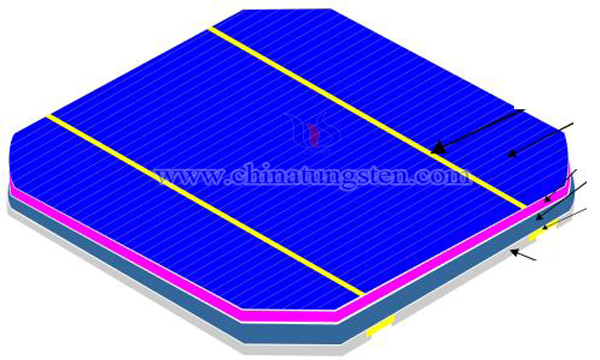Single Layer Nano Tungsten Disulfide Solar Cells Application
- Details
- Category: Tungsten Information
- Published on Saturday, 25 May 2019 22:10
With the sharp rise in oil prices and the depletion of mineral resources, solar energy has attracted more and more attention due to its inexhaustible, unrestricted geographical and clean and safe advantages. Solar cells based on photovoltaic effect to convert solar energy into electricity are one of the main ways to utilize solar energy.

The arrangement of organic solar cells from top to bottom is cathode, electron transport layer, organic photosensitive layer, hole transport layer, anode and substrate. Among them, the hole transport layer is tungsten disulfide nanofilm, which is prepared from tungsten disulfide nanosheets. The preparation method is as follows:
1)Tungsten disulfide nanosheet material dispersion solution was spin-coated on indium tin oxide anode on glass substrate, and then treated by ultraviolet ozone for 5-30 minutes. A single layer of tungsten disulfide nanofilm was prepared as a hole transport layer with a thickness of 1-5 nanometers.
2)The organic photosensitive layer prepared by spin-coating conjugated polymer solution of donor and acceptor on the hole transport layer of tungsten disulfide nano-film is 100 nanometers thick.
3)Electron transport layer was obtained by spin-coating poly [(9,9-bis(3'-(N, N-dimethylamino) propyl) -2,7-fluorene) -alt-2,7-(9,9-hexadecyl fluorene)] on the organic photosensitive layer with a thickness of 5 nanometers.
4)Vacuum evaporated aluminium was used as the cathode on the electron transport layer, and the thickness of the cathode was 100 nanometers. Thus, the organic solar cells with tungsten disulfide nanosheets as the hole transport layer were prepared.
The work function of single-layer nano tungsten disulfide material matches well with common electrode materials and organic semiconductors. It is a suitable hole transport material in theory. When tungsten disulfide nanosheet material is used as a hole transport layer in organic solar cells, a good quality film can be obtained without high temperature annealing. Experiments show that organic solar cells using tungsten disulfide nanosheets as hole transport layer and solar cells using traditional hole transport materials have almost the same photoelectric conversion efficiency.
- Tungsten Oxide Manufacturer & Supplier, Chinatungsten Online: www.tungsten-oxide.com
- Tungsten News & Prices of China Tungsten Industry Association: www.ctia.com.cn
- Molybdenum News & Price: news.molybdenum.com.cn
- Tel.: 86 592 5129696; Fax: 86 592 5129797; Email: sales@chinatungsten.com



 sales@chinatungsten.com
sales@chinatungsten.com